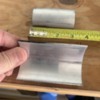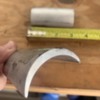XX2 on the Bentley manual. I have one (Orange) for 1968 - 1972 (my chassis is a 1969) and for all the VW stuff, it's great. I liked it so much that when I wrote a service manual for my Speedster I followed the numbering format and order from Bentley.
I also agree that the bolt threads and the length of the bolts is critical, especially when running two stacked shims to get you to 5º+ of caster. The bolt threads should be even with or protruding just a tiny bit on the backside of the frame member - You can see them from the wheel well, tire removed.
@ALB also wrote (translated from the original Northwestern Lumberjack):
"if the beam bolts are the right length and properly torqued they shouldn't come loose, and if you ever have to remove the front beam how do you heat up the thread areas to soften the Loctite up? "
While I agree that they shouldn't come loose, for @30West (I wonder if that's his real name? 🤔  they did loosen up. Might not have had lockwashers on the bolt heads or might not have been torqued properly in the first place, but in loosening enough to drop the shims out, they've probably worn the threads a bit from road vibration so adding Locktite Blue (medium) should be OK. Someone should still be able to remove them years from now, if necessary, without heating anything (this may not be true in Canada, where things are understandably more rugged). Still (see note above), you can get at the backside of the frame member to heat stuff if you really need to.
they did loosen up. Might not have had lockwashers on the bolt heads or might not have been torqued properly in the first place, but in loosening enough to drop the shims out, they've probably worn the threads a bit from road vibration so adding Locktite Blue (medium) should be OK. Someone should still be able to remove them years from now, if necessary, without heating anything (this may not be true in Canada, where things are understandably more rugged). Still (see note above), you can get at the backside of the frame member to heat stuff if you really need to.
Locktite RED (Heavy Duty) is a different matter - That stuff needs Dynamite to get it to break loose after it's cured. It's not labeled "heavy duty" for nuthin'.
And now back to @ALB, Our Northwestern Lumberjack in the Wild Rain Forests of Pacific Northwest British Columbia, where Men are Men and the the bears are hiding:
And here's one for Wolfgang:








